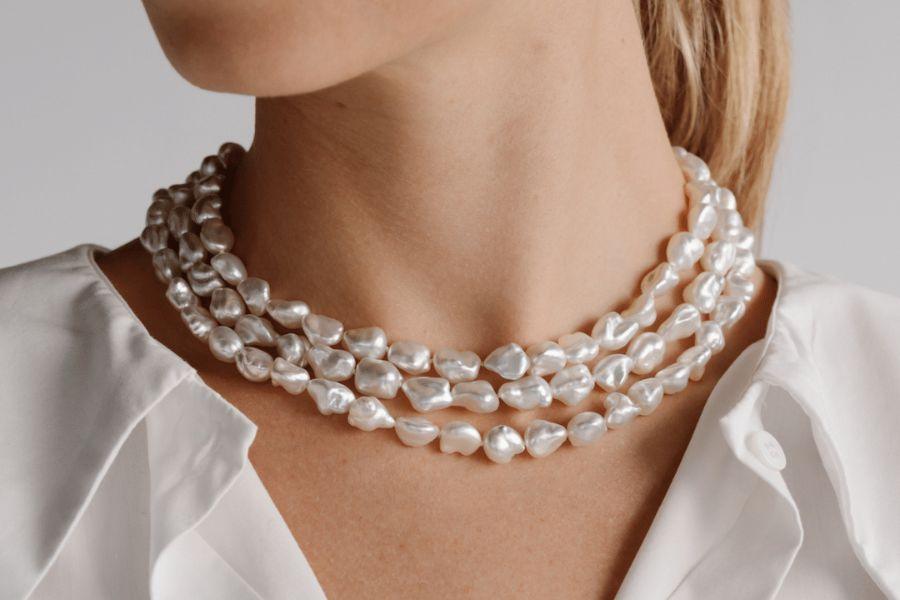Key Takeaways
- Jewelry designers often use the keshi pearl to create unique jewelry pieces. Find out more relevant facts about it, including its origin, characteristics, and common types.
- Keshi pearls and natural pearls are renowned for their unique characteristics and appeal. Here are some tips to help you distinguish the differences between them.
- The keshi pearl is a natural by-product of the cultured pearl. Learn how Keshi pearls are formed and how they are cultured.
What is a keshi pearl?
The Keshi pearl meaning is derived from the Japanese term for 'poppy seeds', are named so because of their unique appearance'. They are all-natural pearls composed of layers of nacre without a shell core. Therefore, they are often small and irregular in shape. They may appear flat, plump or wavy.
Keshi pearls are as valuable as cultured pearls, except for their lack of a nucleus and their brighter luster. In general, Keshi pearls have the following characteristics:
- Size : They vary from very small (2 - 3 mm) to relatively large (15 mm).
- Shape : Keshi pearls come in many shapes, such as round, irregular, semi-irregular, and teardrop. They offer a unique appearance whether used in earrings, bracelets, or other jewelry.
- Color : The color palette includes white, cream, silver, gray, black, and pastel tones such as lavender, pink, and peach. The type of mollusk and environmental factors at the time of formation influence the unique color.
- Density : These pearls are denser than pearls with a core due to their solid nacre composition.
- Surface and Texture : They are smooth. However, small imperfections may appear during the forming process.
- Luster : These pearls shine intensely and reflect light well. Without a nucleus, they have a solid nacre, which accentuates their luster.
- Durability : They are hardy, but like other pearls, they can be damaged by chemicals, heat, and extreme dryness.
- Versatility : Keshi pearls are versatile gemstones. Due to their varied shapes and sizes, they can be incorporated into any jewelry design.

Keshi pearls are composed of layers of nacre without a shell core.
Additionally, Keshi pearls appear on almost every pearl farm that produces cultured pearls. Here are some common varieties of Keshi pearls:
- Akoya Keshi Pearls : They come mainly from Japan and are natural Akoya pearls with a beautiful bright white color. In addition to Japan, China and Vietnam are also major suppliers of high quality Akoya Keshi pearls.
- Tahitian Keshi Pearls : These are by-products of Tahitian black pearls and come from the French Polynesian island of Tahiti. Their beautiful color, with shades of peacock and green, is well recognized. These pearls are an excellent choice for many jewelry styles, especially long chain necklaces.
- South Sea Keshi Pearls : Australia and the Philippines produce some of the most impressive Keshi pearls. They are among the largest of these pearls, with white and golden hues that bring a sumptuous appeal to platinum, gold and silver jewelry.
The Formation of the Keshi Pearl
Keshi pearls are quite distinctive compared to the traditional pearl formation process.
Traditionally, a pearl is formed when an object, such as a shell fragment, becomes embedded in a mollusk, such as an oyster. After infection, the oyster heals by covering the intruder with nacre. This prevents the intruder from disturbing the oyster.
However, Keshi pearls can form in two ways, neither of which follows the "usual" process described above. The first method involves the oyster rejecting and expelling the material—the nucleus—before the pearl is fully formed.
The second method is that the nucleus fractures and splits into two independent pearl sacs, or nacre circles, neither of which have a nucleus. Eventually, one or two nucleusless pearls will form.
Keshi pearls do not have a central nucleus, showing pure nacre. In addition, the absence of a nucleus enhances their luster, creating a stunning radiance. Furthermore, the exceptional luster of these pearls increases their value and demand. They are sold by carat weight as precious materials. When they are made into beautiful jewelry, their value increases even more.

The formation of the Keshi pearl
Keshi pearls do not have a central nucleus, revealing pure nacre. In addition, the absence of a nucleus enhances their luster, creating a stunning radiance. In addition, the exceptional brilliance of these pearls increases their value and demand. They are sold by carat weight as precious materials.
When they are transformed into beautiful jewelry, their value increases even further.
How to differentiate between pearls and Keshi?
Understanding the differences between Keshi pearls and natural pearls is essential to diving into the fascinating world of pearls. Here are some significant variations:
1. Training Process
Keshi pearls are a byproduct of cultured pearl farming. They are formed when the mollusk expels the implanted nucleus while producing nacre. Natural pearls are formed when an irritant enters the mollusk and nacre develops around it.
2. Composition of Mother-of-pearl
Keshi pearls are composed entirely of layers of nacre, giving them a high luster and rich texture. Natural pearls are also made of nacre, but the layers may be uneven. A random irritant causes them to form, leading to variations in the thickness and quality of the nacre.
3. Symmetry and Form
Keshi pearls have organic and uneven shapes due to the lack of a nucleus. In contrast, natural pearls can vary in shape. They tend to be more symmetrical when they grow around a constant irritant. However, both types of pearls lack the ideal roundness associated with cultured pearls with a nucleus.
4. Culture vs. Natural
Keshi pearls are the result of human intervention, including pearl farming. They can sometimes develop naturally after the nucleus has been expelled. In contrast, natural pearls form without human assistance, making their discovery a rare and organic process.

Keshi pearls are the result of human intervention
5. Chandelier
Keshi pearls are renowned for their remarkable luster due to their nacre composition. Natural pearls can also have a high luster, but this depends on the thickness and quality of the nacre layers. Both types are highly prized for the depth of their luster.
6. Attractiveness and Charm
Keshi pearls are unique, with their organic shapes and shiny surfaces, giving them a modern, artistic look. In contrast, natural pearls are formed through natural processes. Their rarity adds to their timeless beauty and mystery, and collectors greatly value them.
7. Rarity
Keshi pearls are unique with their organic shapes and shiny surfaces, giving them a modern and artistic look. In contrast, natural pearls are formed through natural processes. Their rarity adds to their timeless beauty and mystery, and they are highly prized by collectors.
8. Training Environment
Keshi pearls come from controlled environments, such as pearl farms, where the mollusks are monitored. In contrast, natural pearls form randomly in nature, making them harder to find due to the unpredictable conditions.
9. Collectibility
Natural pearls are rare and precious jewels, highly sought after by collectors. Their rarity, history and mysterious formation make them very valuable. Keshi pearls are also interesting with their unique shapes and beautiful mother-of-pearl.
10. Sustainability and Ethics
Thanks to eco-friendly methods, pearl farming is now more sustainable, especially for Keshi pearls. However, harvesting natural pearls still harms marine ecosystems and mollusk populations, posing sustainability challenges. Fortunately, this practice has been reduced due to strict regulations.
11. Value
Collectors value natural pearls more because of their rarity and difficulty in obtaining them. Keshi pearls have excellent luster and unique shapes. They are often less expensive than natural pearls, but exceptional Keshi pearls can be quite expensive.
12. Association with Other Gems
Keshi pearls have unique shapes, brilliance and adaptability that make them often used with other gems in modern jewelry, creating a stunning contrast.
Natural pearls, being rare and organically formed, stand out more in traditional and elegant designs.

Keshi pearls pair well with other gemstones
Keshi Pearl Culture
Typically, a pearl technician makes a small incision in the mollusk's body and inserts a pearl nucleus inside. The mollusk is then returned to water to continue developing into a pearl.
The mollusk covers the nucleus layer by layer with nacre, gradually forming the pearl. However, a non-standard pearl can develop from a Keshi, because the pearl is formed without a nucleus. It is considered a by-product of the culturing process.
Keshi pearls are common in areas where pearl production takes place. Since cultured pearls account for over 95% of the world's production, poppy seed or Keshi pearls are common in areas with extensive pearl cultivation.
Many oysters have these unique pearls. They are mainly found in the Japanese Akoya pearl production. Poppy seed pearls can also be found in Tahiti, Australia, Indonesia and the Philippines, which are known for their thriving pearl harvesting industries.
Large-scale pearl farming in these regions has led to the development of sophisticated methods. From the beginning of the nucleation process, these methods can predict whether an oyster will produce a cultured pearl or a Keshi. Unfortunately, pearl farmers use X-rays to identify abnormalities in pearl growth, making Keshi pearls harder to find.

Keshi Pearl Culture
Keshi pearls are unusual and beautiful, one of a kind. They have a fantastic spectrum of tones and are full of texture. Furthermore, Keshi pearls are unique pearls composed entirely of nacre! They have all the characteristics necessary to be pearls and nothing else! No nucleus, no predefined shape, nothing else!


